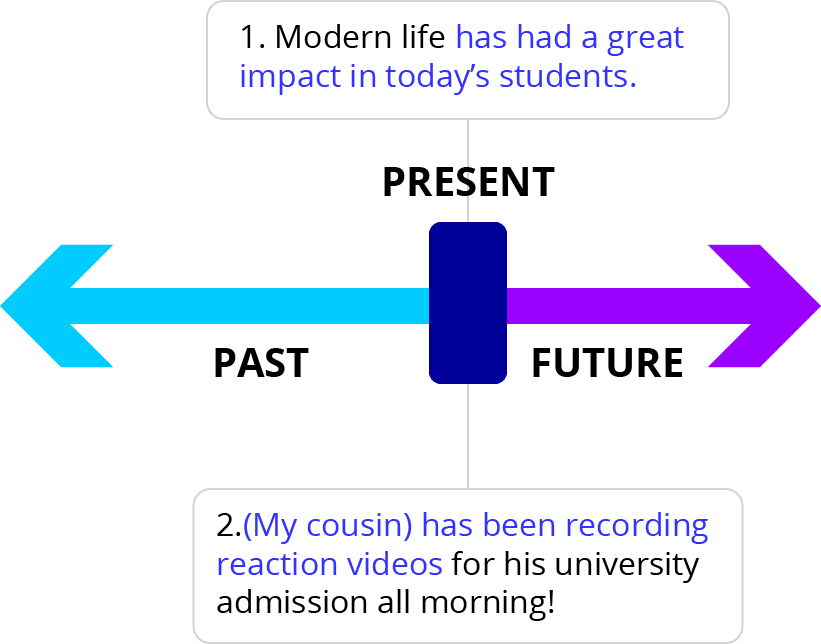1- Preparing for the future
All over the world teenagers have been planning their college life for when they graduate from high school. The big takeaway is reflected into the life decisions they have been making up to this point…has all the studies been enough? Is all this effort coming to a reward? The competition for admission to top universities has always characterized the scenario for end-of-the school year celebrations. My cousin for example, who is a high school senior, has been recording reaction videos for his university admission all morning!

2- Present perfect simple or present perfect continuous?
To talk about past actions that have a present (or even future) impact, and to talk about actions that have characterized people’s activities over a determined period of time we use present perfect simple or present perfect continuous or progressive. For this lesson we are going to focus on the second: present perfect simple or progressive, but let’s first have a look at the main difference between present perfect simple and present perfect progressive.
In the timeline below, you can see a couple of the sentences highlighted in the opening text in a particular position:

For sentence number one, you see that this occupies a space that starts in the past, continues in the present, and my go on to the future. This refers to the present perfect simple, because it indicates an activity that started in the past (when modern life began) continues in the present (today’s modern life) and might continue in the future (teenager’s lives in the years to come). This situation is expressed in the present perfect simple, that is also useful to indicate: a recent past action, and a life experience, as in: ‘this has been the best year of my life’.

On the other hand, in sentence number two, you see that this activity occupies a very limited space between the present and the future. This is because sentence two is expressing an activity that, just as sentence number one, started shortly in the past, continues in the present, but that, in contrast, will finish soon. In ‘He’s been recording admission videos all morning’, we know that he started on the same day, has been doing this for a considerable period of time, but we also know that he is performing an activity that will end soon. That is key for the present perfect continuous or progressive. In this tense, we talk about an activity that is happening within a particular timeframe, but we know almost exactly when it is going to end because of its nature. In the example, we know that this person’s cousin can’t record reaction videos for ever because you only apply for universities a very limited number of times in limited stages in your life.

3- The present perfect continuous or progressive
There is a few elements to consider when forming this tense. These are:
3.1- Time reference or time indicators
Time references or time indicators refer to short phrases or words that help you locate a sentence within a particular timeframe. These are words that can tell you: oh! this is present perfect continuous. Some examples are: all (morning/day/night) this/these (morning/day/ night – days, months) for (x period of time) during (x period of time), or lately. They normally indicate a timeframe that has an ending point.
3.2- The auxiliary that goes with each subject
You won't unfortunately get away with auxiliaries. For present perfect tenses, we use 'have', and 'has' in their positive form, and hasn't (has not) or haven't (have not) in their negatives. We use have or haven't with 'I', 'you', 'we', or 'they'
3.3- Use of 'been' and a verb with -ing ending
In order to form the present perfect continuous, you need to take the following into consideration: the verb phrase is composed by three essential elements: the auxiliary, the participle action 'been', and a verb ending in-ing.
Let’s read these conversations to see examples:
3.4- Positive and negative statements
Tom has been exercising math all morning with but hasn’t been getting the exercises right, maybe he is nervous because he is really good at math.

| So, Matthew, I have been studying math all morning, but still can’t understand this problem. | |
| Ok Tom. I see you have been reading a lot during our recess, but you haven’t been taking the exercises from the right book. This is too advanced! |
3.5- Interrogative sentences
Lori and Megan have been attending yoga lessons at different places. This time, they try to compare their experience with yoga.

| So, Lori, have you been practicing every day during break or…? | |
| Not really. Where have you been going for yoga lately? Is it a nice place? |
3.6 Conclusion
As you can see, perfect tenses are the only tenses that despite using auxiliaries, they always need to conjugate the main verb, that in this case is represented by ‘been’. Now, let’s have a look at a summary of contents for this lesson:
| Present perfect progressive | ||
| Positive | Negative | Interrogative |
| Subject + have or has + been + verb(ing) + time indicator* | Subject + hasn’t or haven’t + been + verb(ing) + time indicator* | (Wh word) + have or has + subject + been + verb(ing) + time indicator* |

